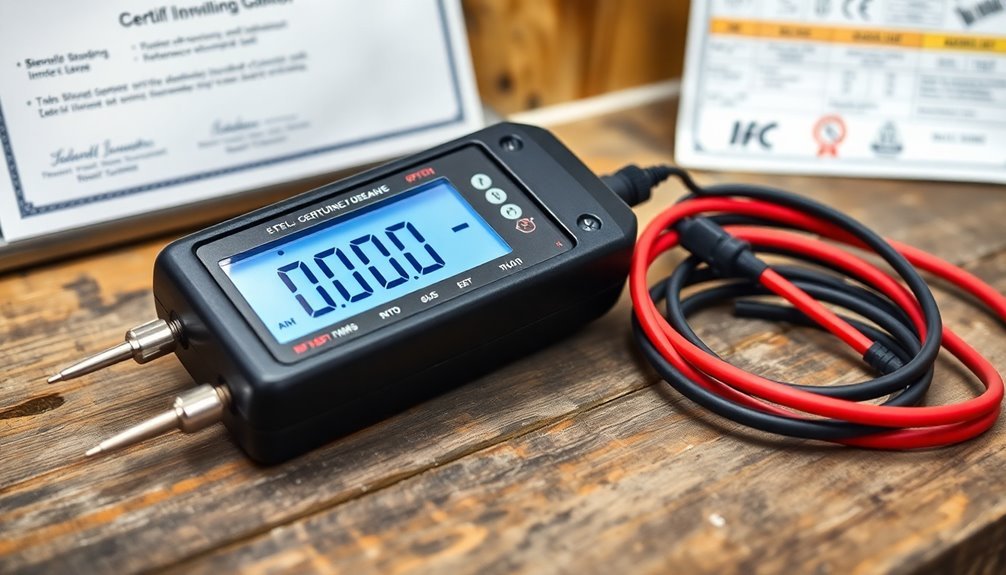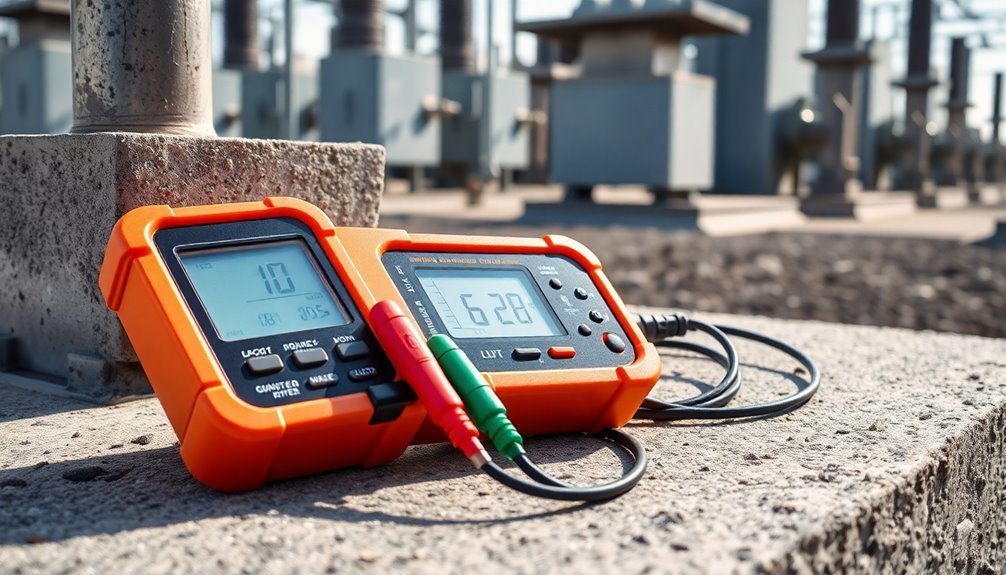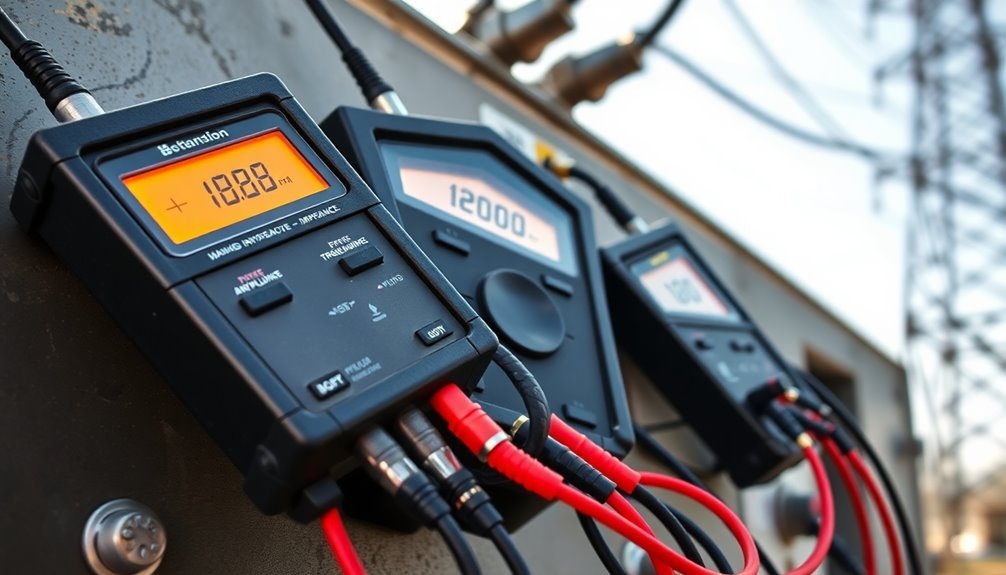When choosing a grounding impedance meter, you'll want to think about whether digital or analog best fits your needs. Digital meters offer superior accuracy, auto-ranging capabilities, and advanced features like wireless data transfer, while being more robust in harsh conditions. For most modern applications, digital meters like the Fluke 1623-2 or AEMC Model 6416 provide excellent accuracy and versatility. Think about your specific testing environment, required measurement range, and whether you need features like non-intrusive testing or soil resistivity measurements. The right choice depends on factors like your budget, testing conditions, and accuracy requirements – factors we'll explore in detail below.
Understanding Grounding Impedance Meter Types

When selecting a grounding impedance meter, you'll first need to understand the fundamental distinction between analog and digital types. Analog meters, like Hioki's classical models, rely on AC phase differential systems for ground resistance measurements. While these have served the industry well, digital meters now offer significant advantages, including auto-ranging capabilities and superior accuracy.
These instruments operate effectively in temperatures from -25°C and can maintain accuracy in harsh field conditions. Modern digital meters, such as AEMC's Model 6416, deliver precision with accuracy ratings of ±(1.5% reading +0.01 Ω). These instruments can measure a wide resistance range from 0.01 to 99.99kΩ, making them versatile for various applications.
Digital meters also come with advanced features you won't find in analog versions, such as wireless data transfer and thorough analysis software.
If you're working with multi-grounded systems, you'll want to think about clamp-on digital meters. These allow you to take measurements without disconnecting the ground system, saving you time and effort in the field.
The combination of accuracy, convenience, and additional features makes digital meters the preferred choice for most modern grounding impedance measurements.
Key Features To Consider
Selecting the right grounding impedance meter requires careful consideration of several critical features. You'll need to assess both environmental factors and instrument capabilities to make an informed choice.
First, consider your testing environment and usage requirements. You'll want a meter that can handle your specific soil conditions and EMI levels. Modern meters like the Smart Ground Multimeter can calculate soil resistivity using Wenner's. If you're working with complex industrial systems, choose a model that offers continuity checking and selective testing capabilities.
For non-intrusive testing needs, a clamp-on meter might be your best option.
Your meter's measurement capabilities should match your testing requirements. Look for instruments with appropriate ground resistance ranges and measurement methods. Choose one with error monitoring features and the ability to perform selective measurements when needed.
Don't overlook practical considerations like battery life and portability. You'll want a meter that can last through your workday and withstand field conditions.
Data handling features, such as memory functions and automatic recording, can improve your efficiency substantially.
Finally, confirm your chosen meter meets relevant safety standards and includes protective features like overload protection and static electricity safeguards. Clear error indicators and accurate readings within specified tolerances are essential for reliable results.
Measurement Range And Accuracy

Among the key features we discussed, measurement range and accuracy stand at the forefront of grounding impedance meter selection. You'll find significant variations across different models, with the Fluke 1623-2 offering the widest range from 0.020 Ω to 19.99 kΩ, while maintaining a consistent ±(2% rdg + 3 d) accuracy for 3-pole measurements.
| Model | Key Range Features | Accuracy | Best For |
|---|---|---|---|
| AEMC 6416 | 0.01-1500 Ω | ±(1.5-25% reading) | High-precision low-range testing |
| Sisco Digital | 0.01-2000 Ω | Not specified | Basic testing needs |
| Fluke 1623-2 | 0.020 Ω-19.99 kΩ | ±(2% rdg + 3 d) | Professional applications |
| APC Smart | Not specified | Not specified | Existing system monitoring |
When you're working with high soil resistivity, you'll need a meter with sufficient test current capability. The AEMC 6416 delivers with its 200A transient current protection, while the Fluke 1623-2 provides >50 mA short-circuit current. Don't overlook resolution capabilities – the Fluke offers 0.001 Ω precision in lower ranges, essential for critical grounding applications where minute variations matter. The device's bright yellow OLED display ensures clear visibility of measurements even in challenging lighting conditions.
Environmental Testing Conditions
Environmental testing factors pose substantial challenges in grounding impedance measurement accuracy. You'll need to think about how soil moisture, temperature, and salt content dramatically affect your readings, with even a 15% increase in moisture potentially reducing resistivity by a factor of 50,000. The impact of soil composition can significantly influence measurements, as clay and organic matter tend to provide higher resistance values.
When selecting your meter, make certain it can handle these variable conditions effectively. Your meter should be capable of functioning in diverse seasonal conditions, as soil resistivity changes markedly throughout the year.
Look for instruments like the Smart Ground Multimeter (SGM) that can operate in energized systems and account for nearby grounds and shield wires. You'll want a device that uses multi-probe arrangements to provide accurate readings despite environmental variations.
Think about meters like the AEMC Ground Resistance Tester Model 6416 that are specifically designed for challenging environmental conditions. Your chosen instrument should be able to perform soil resistivity measurements using extended four-pin methods with multiple probes, providing detailed two-layer soil models.
It's vital to select a meter that offers statistical characterization of measurement accuracy, including expected error versus confidence level, to guarantee reliable results across different environmental conditions.
Real World Applications

While environmental factors shape testing parameters, real-world applications determine which meter features you'll need most frequently. Computer-based multimeters provide enhanced data analysis for complex testing scenarios.
For utility and service entrance testing, you'll want a clamp-on meter if you're working with utility poles and street lighting, as these locations typically have multiple parallel ground connections. Your meter should accurately measure below 20Ω to guarantee effective grounding.
In commercial and industrial settings, you'll need a meter capable of performing 3 and 4-pole Fall-of-Potential testing. You should plan for regular testing every three years, following International Electrical Testing Association guidelines.
When testing multiple ground rods, remember they must be spaced further apart than their length for maximum effectiveness.
For specialized applications like cell towers, power transmission towers, and transformer installations, consider meters that can test without disconnecting the ground system. AEMC's Model 6472, for example, lets you test individual tower legs while keeping overhead ground wires connected.
You'll also benefit from a meter that offers multiple testing methods, including selective, stakeless, and 2-pole techniques, especially when working with low-impedance electrodes or larger grounding systems requiring Tagg Slope analysis.
Frequently Asked Questions
How Long Does a Typical Ground Impedance Meter Battery Last?
You'll get about 8-12 hours of continuous use from your ground impedance meter's battery, or roughly 1,500-4,500 individual tests. Battery life varies by model and usage patterns, so carry spares.
Can Multiple Users Share Calibration Data Between Different Meter Models?
You'll find sharing calibration data between different meter models is limited. While some advanced meters support data sharing through apps and cloud storage, compatibility varies by manufacturer and often requires matching models.
What Safety Certifications Should Operators Have Before Using These Meters?
You'll need electrical safety training, OSHA certification, manufacturer-specific training, and IEC compliance certifications. Don't forget to maintain current PPE certifications and stay updated on safety standards through regular recertification programs.
How Often Should Grounding Impedance Meters Be Recalibrated?
You'll need to recalibrate your grounding impedance meter annually, starting from your receipt date. Regular calibration guarantees accuracy, maintains compliance with standards, and reduces the risk of incorrect measurements.
Are There Smartphone Apps Available for Remote Monitoring of Measurements?
You'll find some grounding meters offer smartphone apps for remote monitoring. The AEMC Model 6417 has an Android app, while WinSGM software works on Windows devices for data viewing and control.
In Summary
You'll need to carefully evaluate your specific testing requirements when selecting a grounding impedance meter. Consider the measurement range, accuracy level, and environmental conditions you'll encounter in your work. Whether you're testing industrial equipment or residential installations, choose a meter that's durable, reliable, and matches your budget. Remember, proper grounding measurements are vital for safety and equipment protection.





Leave a Reply